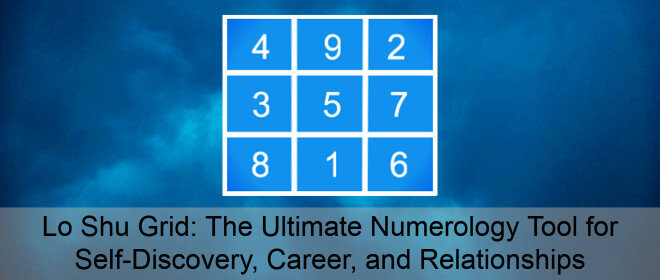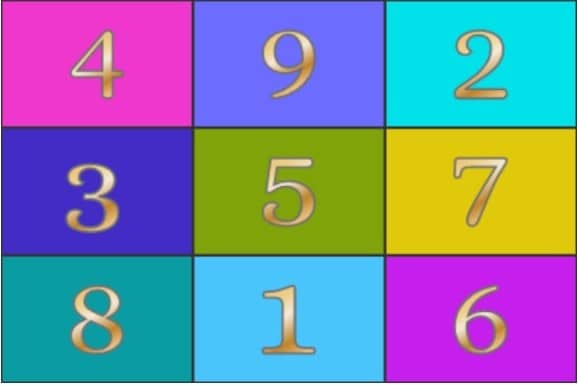
Lo Shu Grid: The Ultimate Numerology Tool for Self-Discovery, Career, and Relationships
Introduction to the Lo Shu Grid
The Lo Shu Grid, originating from ancient numerology, is a mystical square that is deeply rooted in the belief of cosmic energy and its influence on life. This grid is essential in numerology, used to interpret an individual’s life path, personality traits, and even potential challenges. In this guide, we will explore the Lo Shu Grid in its entirety, unravelling its mysteries and practical applications.
The Significance of Numbers in Lo Shu Grid
Each number in the Lo Shu Grid represents specific attributes and carries a unique energy. Before we delve into the mechanics of the grid itself, let’s explore what each number signifies:
1 (Water – Communication & Wisdom): Reflects intelligence, adaptability, and strong communication skills. Individuals with multiple 1s are articulate, intuitive, and persuasive.
2 (Earth – Partnerships & Sensitivity): Represents emotions, relationships, and nurturing qualities. A strong presence of 2s indicates empathy and deep connections with others.
3 (Wood – Creativity & Expression): Symbolizes artistic abilities, emotional intelligence, and innovation. Those with 3s in their grid excel in creative pursuits.
4 (Wood – Stability & Hard Work): Associated with discipline, organization, and determination. A dominant 4 indicates a structured, responsible personality.
5 (Center – Change & Freedom): The central number represents balance, adaptability, and the ability to embrace transformation.
6 (Heaven – Leadership & Responsibility): Reflects leadership, accountability, and protective qualities. Those with strong 6s tend to take charge and offer guidance to others.
7 (Metal – Intuition & Spirituality): Represents introspection, wisdom, and a deep connection to the spiritual realm. Individuals with 7s are intuitive and analytical.
8 (Earth – Wealth & Knowledge): Symbolizes prosperity, ambition, and financial stability. A presence of 8s indicates strong decision-making skills and a focus on success.
9 (Fire – Ambition & Fame): Associated with achievement, recognition, and leadership qualities. Multiple 9s reflect a highly ambitious and driven personality.
How the Lo Shu Grid Works
The Lo Shu Grid is a 3×3 grid filled with numbers from 1 to 9. By positioning an individual’s birth date into the grid, it reveals insights about their character, strengths, weaknesses, and even life path. Let’s break down how the Lo Shu Grid is applied:
Step 1: Calculate the Core Numbers
To construct the grid, you first need to calculate the core numbers derived from your birth date. Here’s an example: For someone born on 5th June 1992:
- Day: 5
- Month: 6
- Year: 1992 (1 + 9 + 9 + 2 = 21 → 2 + 1 = 3)
Step 2: Place the Core Numbers in the Grid
Once you have calculated the day, month, and year, you place these numbers into their corresponding positions in the Lo Shu Grid. Each number corresponds to a specific area of life, revealing insights about one’s personality, career, relationships, and spiritual path.
The Lo Shu Grid Template:

Driver, Conductor, and Kua Numbers: An Introduction
Before we dive into the actual Lo Shu Grid, it’s important to understand the foundational numbers in numerology that directly impact how we interpret the grid. These are the Driver, Conductor, and Kua numbers.
Driver Number: The Core Personality
The Driver number, also known as the Life Path Number, represents your core personality and is derived from your birth date. It highlights your character traits, core strengths, and life challenges.
How to Calculate the Driver Number
The Driver number is calculated from the day of birth. If you were born on a single-digit day, that number is your Driver. If born on a double-digit day, you reduce it to a single digit by adding the two digits together.
For example:
- Born on the 15th: 1 + 5 = 6 (Driver number is 6)
- Born on the 3rd: 3 (Driver number is 3)
Conductor Number: The Supporting Personality
The Conductor number, also known as the Destiny Number, represents the complementary traits that support your Driver number. It is calculated using the sum of the digits of your full birthdate (day, month, and year), reduced to a single digit.
How to Calculate the Conductor Number
To calculate the Conductor number, follow these steps:
- Write down your birth date in the format DD/MM/YYYY.
- Add all the digits together to get a total.
- If the sum is a double-digit number, reduce it by adding the digits together to get a single digit.
For example:
- Birthdate: 5th June 1992
- Day: 5
- Month: 6
- Year: 1992
- Add them together: 5 + 6 + 1 + 9 + 9 + 2 = 32
- Reduce: 3 + 2 = 5 (Conductor number is 5)
This number represents how others perceive you and what type of energy you emit. The Conductor number often complements the Driver number, providing balance or adding nuances to your personality.
Kua Number: The Feng Shui Influence
The Kua number is a fundamental aspect of Feng Shui and is used to determine your favorable and unfavorable directions for success, health, relationships, and personal growth. It is calculated differently for males and females.
How to Calculate the Kua Number
There are different formulas for calculating the Kua number based on gender and birth year.
- For Males:
- Add the four digits of your birth year.
- If the result is a double-digit number, reduce it to a single digit by adding the digits together. Say if the result is 5,
- Subtract the final single digit from 11.
- the Kua number becomes 6.
Example (Male born in 1992):
- Year four digits:1 + 9 + 9 + 2 = 21 → 2 + 1 = 3
- Subtract from 11: 11 – = 8 (Kua number is 8)
- For Females:
- Add the four digits of your birth year.
- If the result is a double-digit number, reduce it to a single digit by adding the digits together.
- Add 4 to the final single digit.
- If the result is 4, the Kua number becomes 8.
Example (Female born in 1992):
- Year four digits:1 + 9 + 9 + 2 = 21 → 2 + 1 = 3
- Add 4: 3 + 4 = 7 (Kua number is 7)
The Kua number offers insights into your favorable directions and the best areas in your home or workspace to enhance various aspects of your life, such as career, health, or relationships.
Placing Numbers in the Lo Shu Grid
Now that we understand the significance of the Driver, Conductor, and Kua numbers, let’s explore how to place numbers in the Lo Shu Grid based on your birthdate and the rules of numerology.
Step-by-Step Rules for Placing Numbers
- Use the Birthdate Numbers: The primary numbers used in the Lo Shu Grid are derived from your birthdate (Driver and Conductor numbers). The day, month, and year of birth provide the numbers that will be placed in the grid.
For example:
- Birthdate: 5th June 1992
- Day: 5
- Month: 6
- Year: 1992 (1 + 9 + 9 + 2 = 3)
- Birthdate: 5th June 1992
- Assign the Numbers to the Grid Positions: The Lo Shu Grid is a 3×3 square, with specific positions for each number from 1 to 9. Here’s how the numbers should be placed:
- 1 goes in the bottom-middle square.
- 2 goes in the top-right square.
- 3 goes in the middle-left square.
- 4 goes in the top-left square.
- 5 goes in the center.
- 6 goes in the bottom-right square.
- 7 goes in the middle-right square.
- 8 goes in the bottom-left square.
- 9 goes in the top-middle square.
- Place Each Birth Number in its Corresponding Position: Based on the calculated numbers, place each digit in its appropriate position. If the same number appears multiple times in the birthdate, place it multiple times in the grid. If a number is missing from the birthdate, it will not appear in the grid, and this indicates an area of life that may need more attention.
Interpreting Missing and Excessive Numbers in the Lo Shu Grid
Missing Numbers:
Missing 1: Difficulty in self-expression and communication.
Missing 2: Struggles with emotional connections and teamwork.
Missing 3: Lack of creativity and difficulty in innovation.
Missing 4: Struggles with discipline and organization.
Missing 5: Resistance to change and difficulty adapting.
Missing 6: Avoidance of responsibilities and leadership roles.
Missing 7: Weak intuition and disconnection from spirituality.
Missing 8: Financial instability or lack of material focus.
Missing 9: Lack of ambition and motivation.
Excessive Numbers:
Excess 1: Overconfidence, dominance, and potential arrogance.
Excess 2: Emotional sensitivity, dependence on others.
Excess 3: Scattered energy, lack of focus.
Excess 4: Rigidity and excessive caution.
Excess 5: Restlessness and impulsive decisions.
Excess 6: Over-involvement, taking on too many responsibilities.
Excess 7: Isolation and overthinking.
Excess 8: Materialism and aggressive ambition.
Excess 9: Idealism without practical execution.
By understanding these patterns, individuals can take corrective actions to balance their energies, improve their weaknesses, and harness their strengths for a fulfilling life.
Practical Applications of the Lo Shu Grid
- Self-Reflection and Personal Growth
The Lo Shu Grid can be used as a powerful tool for introspection. By identifying missing numbers, individuals can focus on developing areas that may be weak or underutilized. For example, if a person lacks the number 4 (order), they can consciously work on building routines and structure in their life.
- Relationships and Compatibility
Numerology experts often use the Lo Shu Grid to assess compatibility between individuals. By comparing grids, it becomes clear where two people align and where potential conflicts may arise. For example, one person may have a strong presence of 6s (authority and responsibility) while their partner lacks this, leading to possible issues around decision-making or leadership roles in the relationship.
- Career Guidance
The Lo Shu Grid also offers valuable insights into career paths. Certain numbers are more aligned with leadership (6), creativity (3), or communication (1), and understanding one’s strengths can help guide career decisions. For example, a person with strong 3s may thrive in a creative field, while someone with a strong presence of 6s may excel in leadership roles.
- Spiritual and Emotional Growth
The numbers 7 and 9 in the grid are linked to spiritual and emotional growth. A well-balanced grid with these numbers present suggests an individual who is attuned to their emotions and spirituality. If these numbers are missing, it may indicate that the person needs to focus more on inner growth and emotional well-being.
- Enhancing Feng Shui
In Feng Shui, the Lo Shu Grid is used to assess energy flow in homes or workplaces. Each number corresponds to a specific area of life, and Feng Shui practitioners use the grid to align the energy of a space with the personal grid of the inhabitants. For example, enhancing areas related to the number 8 (wealth and knowledge) can help boost financial success.
How to Work on Missing Numbers:
• Missing 1 (Communication Issues): Work on improving communication skills through public speaking, writing, or engaging in conversations with others.
• Missing 2 (Lack of Empathy): Focus on building deeper connections with others and understanding their emotions.
• Missing 3 (Lack of Creativity): Engage in creative activities like art, writing, or music to develop this area.
• Missing 4 (Disorganization): Create routines, set goals, and focus on building structure in daily life.
• Missing 5 (Lack of Flexibility): Practice adaptability by trying new things, embracing change, and being open to different perspectives.
• Missing 6 (Avoiding Responsibility): Take on leadership roles and embrace accountability in both personal and professional settings.
• Missing 7 (Spiritual Disconnection): Explore spiritual practices such as meditation, yoga, or journaling.
• Missing 8 (Financial Instability): Work on financial discipline, budgeting, and setting long-term financial goals.
• Missing 9 (Lack of Ambition): Set ambitious goals, create a vision board, and work on developing a success mindset.
For more Information and Remedies Click Here
How to Work on Excess Numbers:
• Excess 1 (Overconfidence and Dominance): Focus on humility and collaboration. Practice active listening, share leadership roles, and avoid being overly controlling or self-centered.
• Excess 2 (Over-sensitivity and Dependency): Build emotional resilience and independence. Set healthy boundaries in relationships and learn to balance your sensitivity with self-confidence.
• Excess 3 (Scattered Energy and Overindulgence): Develop discipline and focus. Prioritize tasks, avoid overindulgence in pleasures, and create a structured approach to creative projects.
• Excess 4 (Rigidity and Over-cautiousness): Practice flexibility and spontaneity. Allow yourself to be open to change, and try to balance work with leisure. Let go of excessive control over details.
• Excess 5 (Restlessness and Impulsiveness): Ground yourself by creating routines and focusing on long-term goals. Practice patience, avoid overindulgence in constant change, and cultivate stability.
• Excess 6 (Overbearing and Self-sacrificing): Learn to set boundaries and avoid over-involvement in other people’s lives. Balance caregiving with self-care and avoid becoming overly controlling in relationships.
• Excess 7 (Isolation and Over-analysis): Engage in social activities and balance intellectual pursuits with emotional expression. Avoid becoming too detached or absorbed in overthinking.
• Excess 8 (Materialism and Aggression): Focus on balancing material success with emotional and spiritual well-being. Practice generosity, and avoid letting power and control dominate your relationships.
• Excess 9 (Idealism and Escapism): Stay grounded in reality by setting practical goals. Avoid being overly idealistic or losing touch with the present moment, and work on balancing emotional depth with practical responsibilities.
Career Guidance Based on Lo Shu Grid Numbers
Each number in the Lo Shu Grid influences career choices based on its energy and characteristics. Here’s a detailed look at the ideal career paths for each number:
1 (Wisdom & Communication):
- Public speaker, Journalist, Writer, Editor
- Lawyer, Teacher, Motivational Speaker
- Radio Jockey, TV Anchor, Politician
- Entrepreneur, Business Consultant
- Marketing Manager, Public Relations Specialist
2 (Partnerships & Sensitivity):
- Therapist, Counselor, Psychologist
- Social Worker, Human Resources Specialist
- Nurse, Doctor (specializing in patient care)
- Event Planner, Wedding Coordinator
- Customer Service Representative
3 (Creativity & Expression):
- Artist, Graphic Designer, Animator
- Actor, Musician, Photographer
- Fashion Designer, Interior Decorator
- Advertising Executive, Copywriter
- Content Creator, Social Media Influencer
4 (Stability & Hard Work):
- Engineer, Architect, Civil Engineer
- Accountant, Auditor, Financial Analyst
- Project Manager, Operations Manager
- Military, Police Officer, Security Analyst
- Factory Supervisor, Construction Manager
5 (Change & Freedom):
- Travel Blogger, Tour Guide, Flight Attendant
- Sales Executive, Marketing Strategist
- Journalist, Freelance Consultant
- Pilot, Explorer, Adventure Sports Coach
- Stock Market Trader, Entrepreneur
6 (Leadership & Responsibility):
- CEO, Business Owner, Manager
- Lawyer, Judge, Political Leader
- Teacher, Principal, Academic Administrator
- Healthcare Administrator, Non-Profit Organizer
- Corporate Trainer, Team Leader
7 (Spirituality & Intuition):
- Philosopher, Astrologer, Spiritual Guide
- Yoga Instructor, Meditation Coach
- Research Scientist, Data Analyst
- Librarian, Historian, Archaeologist
- Detective, Private Investigator
8 (Wealth & Knowledge):
- Banker, Investment Advisor, Wealth Manager
- Business Consultant, Real Estate Developer
- Economist, Venture Capitalist
- Stock Market Analyst, Financial Advisor
- Corporate Lawyer, CEO
9 (Ambition & Fame):
- Actor, Celebrity, Public Figure
- Sports Athlete, Coach, Motivational Speaker
- Social Activist, Philanthropist
- Politician, Diplomat, UN Representative
- Author, Bestselling Novelist, Director
The Lo Shu Grid and Modern Numerology
Although the Lo Shu Grid originates from ancient Chinese culture, its principles continue to influence modern numerology. Many numerologists today use the grid as a foundation for deeper explorations into personality, life purpose, and spiritual growth. With advancements in technology, some practitioners have even developed apps to calculate and interpret the Lo Shu Grid digitally.
Conclusion: Embracing the Power of the Lo Shu Grid
The Lo Shu Grid is more than just an ancient artifact; it is a powerful tool for self-discovery, personal growth, and life enhancement. Whether you are seeking to improve your career, relationships, or spiritual path, the grid offers deep insights into the strengths and challenges that shape your life.
Author
Rajesh Shethia is an experienced Consultant specializing in providing personalized readings and remedies for various life challenges, including Career, Relationships, Finance, and Physical and Emotional Health. His expertise spans multiple disciplines including Astrology, Numerology, Vastu, and Chakra Balancing, enabling him to offer holistic solutions tailored to individual needs. Clients can contact him for Online Consultations or visit his store in Bangalore for an in-person session. To learn more about the effectiveness of his guidance, one can see the Box2Joy Google Profile page and explore customer reviews. Google Map link for our store location - https://maps.app.goo.gl/8mQfJBVYw45zDGZm9 Online Consultation Chat Link - wa.me/+918880666664

